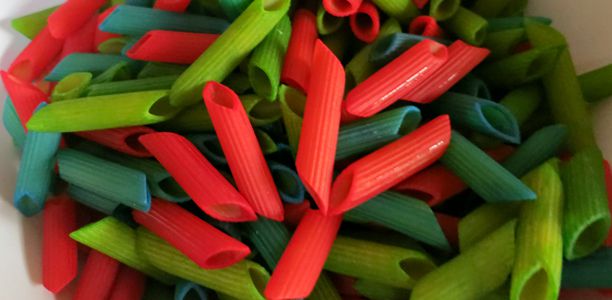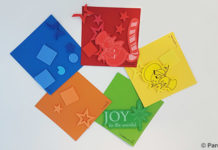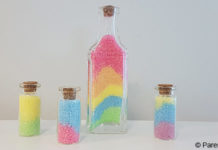Age
2 – 7 years
Duration of activity
Up to 20 minutes
Materials/equipment
- Dried tube pasta (choose shape to meet your child’s ability level)
- Snap-lock bags
- Coloured food dyes of your choice
- Optional: glitter
- Cling wrap
- Hand sanitiser (alcohol, no-wash type)
- String
- Scissors
- For younger children
- Option 1: darning needle (a blunt plastic needle available at sewing/knitting stores); or
- Option 2:
- Skewers (bamboo skewers used for making kebabs – available from your local grocery shop)
- Sticky tape
Cost
Most of these items you would already have at home, so cost should be negligible. Darning needles are low cost; usually about $2 for a pack of 4. But you can use option 2 and not spend any money.
Preparation

- Pour some pasta into a bag (as much as you want to dye a certain colour).
- Add a few squirts of hand sanitiser.
- Add a few drops of food dye.
- Optional: sprinkle in some glitter.
- Close bag and mix well until all pasta is required colour. If pasta is not to required intensity, add a few more drops of food dye.
- Lay out cling wrap flat on counter top.
- Spread pasta flat over cling wrap to dry.
- Leave to dry overnight.
- Repeat as many times are you like with various colours of food-dye.
- Children can help with the preparation of this activity. Ask them what colours they would like the pasta to be. Ask your child which basic food dye colours could be mixed to create the desired colour pasta (e.g. red and blue to make purple).
What to do
- Put all the dry coloured pasta into a large bowl. (Your chil
 d may enjoy doing the pouring or just putting their hands through the pasta as a sensory activity.)
d may enjoy doing the pouring or just putting their hands through the pasta as a sensory activity.) - Take a length of string and cut to desired length (for use as a bracelet/necklace/crown). Remember that once string has pasta on it, it will become a bit shorter.
- Ask your child to choose a piece of pasta and thread onto string. Wrap the string around the first piece of pasta and knot it to create a stopper, so the other pieces do not fall off the string.
- Ask your child to thread the string through the pasta until the thread is full. As your child does this, take the opportunity to ask them about:
- How many pieces of pasta they think they will need and then count the pieces at the end to see how close they were. For older children you can teach math estimation based on the size of each piece of pasta and by measuring the length of string with a ruler.
- Talk about the colours of pasta they are using and in what order – discuss patterns. How many pattern repetitions are there? This is also a good learning opportunity for teaching multiplication – e.g. 6 lots of red/blue/green – 6 lots of 3 makes 18 – count them.
- If you are using different types of pasta, take the opportunity to discuss the shapes of e.g. macaroni vs penne pasta – what do they resemble in real life?
- Tie a knot between the two ends of the string to create a necklace/bracelet.
For younger children
Give younger children the opportunity to succeed at this task by making these adjustments:
- Tie a knot around the first piece of pasta for them.
- At the other end of the string:

- Option 1: thread the string through a darning needle and tie a knot around it (which can be cut off later) so the needle does not fall off the string.
- OR Option 2: make a ‘needle’ but cutting a length of skewer which is longer than a piece of pasta. Use sticky tape to attach the skewer to the string.
- The first time they do this activity, use a shorter piece of string and make a bracelet rather than a necklace so that they can succeed at an activity which does not take too long. They may then feel encouraged to make a longer one on their own.
Extension activities
- Have your child make jewellery from a pattern template, so that they have to copy the pattern rather than make it up as they go along. For example, you could draw different colour patterns on a piece of paper for them to copy, or make one necklace and ask them to make another that is exactly the same.
Tips
- For younger children use large pasta tubes. For older children, you can use a variety of smaller pasta tubes (small penne, macaroni etc).
- The pasta used in this activity stores really well in a plastic container. Make a large batch so you can have several sessions of no-prep play.
- Add in some plain uncoloured pasta to the bowl – it adds another colour to the mix with no preparation.
- As pasta is already a yellow colour, staining with yellow does not work very well unless you use a lot of yellow food colouring to make a fluorescent yellow.
- This activity works better with white pasta than with wholemeal pasta.
- Add the completed jewellery to your child’s dress up box.
- This is a great activity for a portable ‘busy bag’ (a bag to take with you and keep your child busy while you are waiting in a cue at the bank or to do while sitting in the car waiting to pick up older kids from school). It is light and transportable – just fill a snap-lock bag with enough pasta for a couple of necklaces and a couple of lengths of string.
- This makes a great lolly-free party bag. Simply use a decorative bag or decorate a snap lock bag yourself with stickers ribbon and put a couple of handfuls of pasta, lengths of string (and depending on age of kids maybe pre-tie first pasta knot and include a plastic darning needle). Both boys and girls will enjoy this take home activity and parents will appreciate sending their home with something educational rather than sugar!
- Alternative threading idea: cut up lengths of coloured straws. Just make sure the straws you use are a similar diameter or they will slip over each other rather than sitting on the thread in a row.
Safety
- Supervise that your child does not eat the pasta.
- If using a skewer as a ‘needle’ for younger children, ensure that you cut off any sharp ends. Children must sit down while doing this activity – do not allow them to run around while holding the skewer.
- Supervise children while using scissors.
Educational outcomes
Fine motor skills
Threading beads is a great way to develop your child’s fine motor skills, that is, control of the muscles in their fingers which allow them to make precise movements. Fine motor skills are the basis for writing and performing ‘fiddly’ tasks. This activity will also improve their hand-eye coordination.
Mathematical skills
Patterns, colours, shapes and sizes are key mathematical concepts and this activity will help your child grasp them. Children aged 2-3 will still be learning the skills they need to sort objects (e.g. according to size and colour), so they might benefit from sorting the different coloured beads into piles before they begin. Older children will probably have mastered the skill of sorting already, and may get more out of this activity by doing things like copying a pattern (see extension activity) or discussing the characteristics of the patterns they have made. You’ll also be helping your child master mathematical concepts by discussing the size of the necklaces (using word like long and short, or for toddlers just big and small) and shape of the pasta beads.
Making pasta necklaces also offers many opportunities to teach your child about counting, addition and multiplication. For 2-4 year olds just counting the beads might be enough of a challenge.Virginia But older children will be able to perform mathematical sums, (for example tell you that they started with three beads on the string and added another three so now they have six.
Language and communication skills
Even though using words to engage in conversation is something that people ‘just seem to know’, little people don’t. They learn words and the ability to use them to have meaningful conversations in the first few years of life. It’s a classic case of practice makes perfect- all you really need to do to help your child learn new words and develop communication skills is talk with them. Use simple language and sentence structure for toddlers and increase the complexity of the grammar and words you use as your child grows up and expands their vocabulary and grammatical skills.
References
- Virginia Early Childhood Development Alignment Program. Milestones of child development- A guide to young children’s learning and development from birth to kindergarten. 2009. (cited 26 July 2013). Available from: (URL Link) URL Link
- Virginia Early Childhood Development Alignment Program. Good start, grow smart- South Caroline Early Learning standards for 3, 4 and 5 year old children. 2009. (cited 20 September 3013). Available from: URL Link: URL Link



 (20 votes, average: 4.40 out of 5)
(20 votes, average: 4.40 out of 5) 






